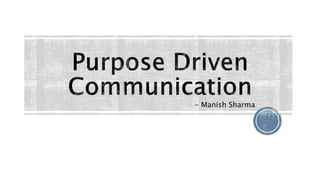
Purpose Driven Communication
- 3. Know your why Importance of aligning the purpose with communication Benefits of the same Answer to the question – HOW Common mistakes while communicating
- 5. Purpose Clarity Key Statements to Lead Communicate to Your Brain First Identify The Hurdles Fight of RIGHT with RIGHT 3 Steps Ahead Approach Spell Bound Context Setting
- 6. Communication Style & Approach Confident Body Language Soulful Pitching Remember The Best Pitch ! You Ever Had What Matters The Most (Other’s Purpose) Be The Complement Put On Your “Real Person” Hat Manage Your Anxiety
- 7. View presentation as a conversation, not a performance! Performance has right and wrong rules, but conversation is more natural. There is no “one right way” to converse.
- 8. Your fundamental job as a communicator is to be in service of the audience. Understand their needs by listening.
- 9. Useful structure 1: Problem/Opportunity → Solution → Benefit Useful structure 2: What? → So what? (Why it’s important) → Now what? (Next steps)
Editor's Notes
- Reinforce. It isn’t enough to explain the connection between your company’s purpose and its strategy — and between that strategy and its execution — once. You’ll need to repeat the message in order to increase understanding, instill belief and lead to true change overtime.
- Greet/Acknowledge Anxiety. Acknowledge your anxiety first to stem the tide of anxiety spiraling out of control. Reframe how you see the situation: View presentation as a conversation, not a performance! Performance has right and wrong rules, but conversation is more natural. There is no “one right way” to converse. How to reframe the situation? Start with questions. Questions are dialogic (Two way). They get the audience involved, as if in conversation. Use conversational language. Many nervous speakers distance themselves conversationally with pronouns they use. Be present-oriented: Focus on the present, not future consequences. Don’t anticipate what to say. Try tongue twisters. Warm up your voice: Most nervous speakers don’t warm up their voice. They retreat into their heads.
- Ask Yourself, “What Does My Audience Need to Hear From Me?”
